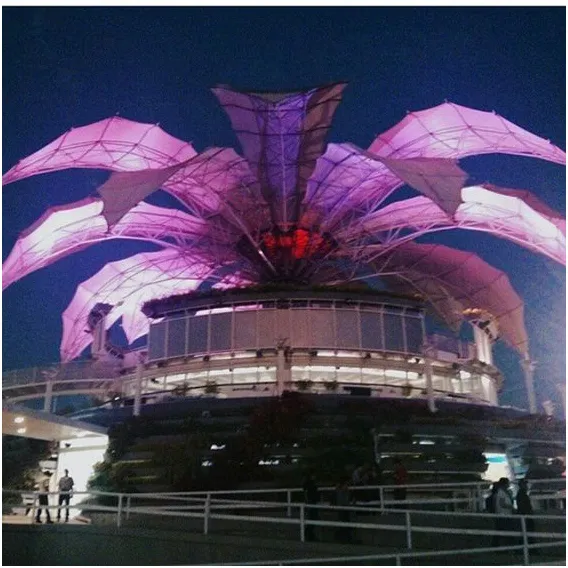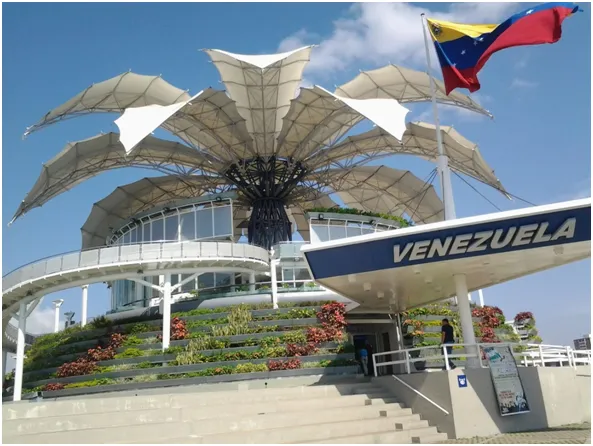
Image
Dear friends of this great community. On this occasion I am very proud to be able to share with you one of the architectural jewels of my hometown, Barquisimeto, located 350 kilometers from Caracas. Barquisimeto, capital of the Lara State, has been called the musical capital of the country because it is the state where great musicians such as the famous guitarist Alirio Díaz or the young conductor Gustavo Dudamel have emerged, where the Venezuelan Orchestra System was also created under the direction of the teacher José Antonio Abreu. But in addition to musicians, in Barquisimeto you will find some of the most important and impressive works of modern architecture in the country, which I will have the pleasure to present to you in some posts in the near future. I hope you enjoy them as much as I do.
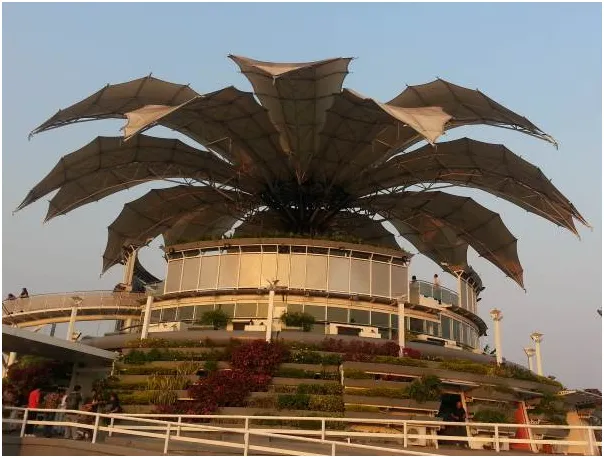
The Venezuelan Pavilion called by its author "A flower of Venezuela for the world", is the product of the brilliant mind of the architect, from Tachira, Fruto Vivas with the collaboration of Frei Otto, which was thought to represent Venezuela in the ExpoHannover exhibition in June of the year 2000, where 156 countries participated. The pavilion that would occupy an area of 1600 square meters, had to meet three requirements, unite the variables "humanity, technology and nature" in a single work. The design had to be carried out in a short time of 9 months, which did not allow the author and his collaborators to develop and experiment totally new solutions; however, the success was of such a nature that the Germans were so satisfied with the work that they built a replica which has been placed where the fair was.
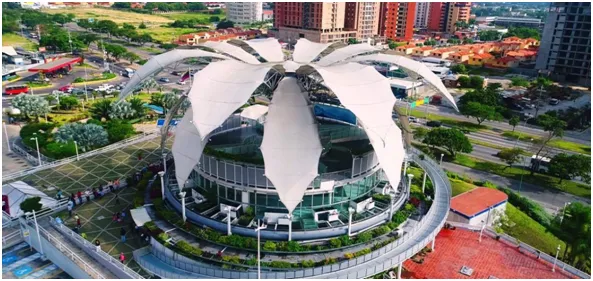
Fruto Vivas managed to overcome difficulties and produced a work that exposes the country's biodiversity, with the use of an ecological solution that adapts to environmental conditions through the use of cutting-edge technologies and the design and construction of an innovative structure that takes advantage of natural light. and it is ventilated and cooled without any electrical consumption, due to the air circulation by convection through the perimeter staggered planters towards the central capital. All this broke with the pre-existing schemes of its time, which was recognized by the award given as the first design prize, among 487 contestants, in addition to being cataloged as the first mutant structure of the 21st century, and being the pavilion visited by 18 million people at the Hannover fair, second only to Germany.
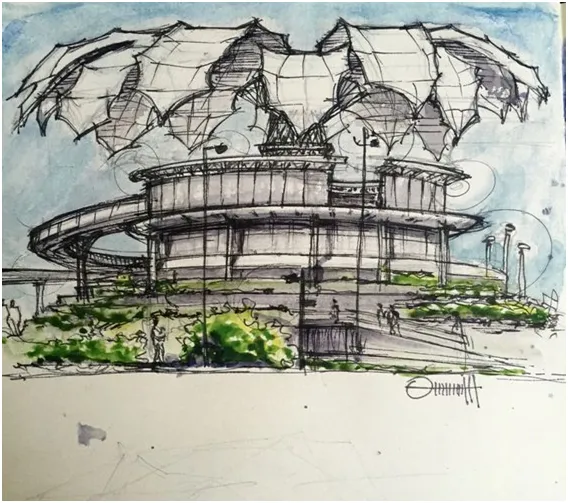
While all the structures were destroyed at the end of the exhibition, the Venezuelan pavilion was disassembled and transferred to its native country, where it was stored in containers for six years. Originally it was thought that it would be rebuilt in Caracas in the Parque del Este, now Parque Miranda, but for reasons that are not relevant, an agreement was not reached, so another headquarters had to be found, with the luck that the city of Barquisimeto made the decision to set it up on their premises, which was achieved after three years of difficult and arduous work and turned it into the "Flor de Venezuela Cultural Center", which was later declared "Cultural Heritage of the nation". As an ecological fact, it can be said that during the construction there was no waste because it was carried out dry, with recyclable materials that can be dismantled without causing contamination.
The structure was rebuilt between Venezuela and Argimiro Bracamonte avenues in the capital of the state of Lara; inside there is a sample of the multiple and rich national fauna and flora, some two hundred thousand scientifically identified plants and two thousand six hundred fish distributed in fish tanks have been exhibited. On the other hand, the flower has a library, an amphitheater, stages for forums, conferences and for the realization of artistic and cultural manifestations.
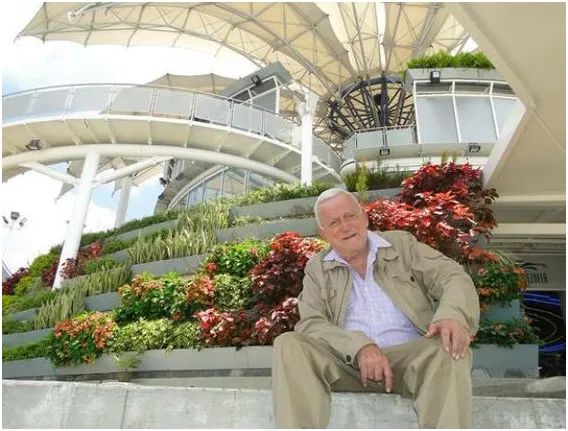
Image
The work is a circular building, similar to a flower, 38 meters in diameter and 6 stories high around a central mast where the elevator circulates and it is also the support of the roof made up of 16 mobile petals. The stem of the flower is an 18 meter high pole built in tubular lattice to make it light and give it transparency. The giant petals that are around the mast open or close to favor the internal temperature of the structure that, when the flower is fully open, displays a diameter of 38 meters. The 16 ten-meter petals open in the presence of the sun and close when the rain appears in the sky. At night they light up with various colors.
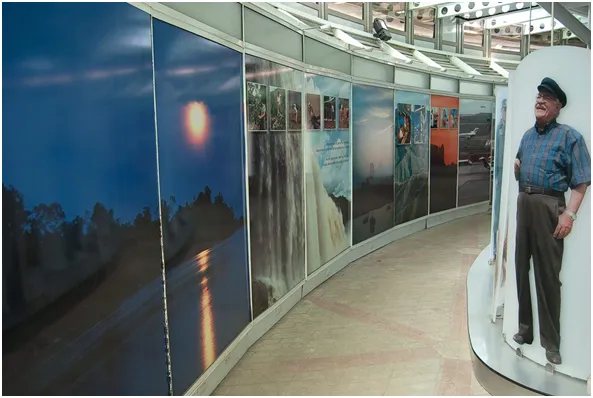
The cover resembles a flower; Fruto Vivas, when designing the structure of the work, had in mind the tepuis of the Gran Sabana and the orchid Cattleya mossiae which is the national flower of Venezuela, so it should be shown with movements similar to those of the petals, For this reason, the cover is a textile membrane whose support is a light tubular structure that adapts to the different positions that the petals take during their movements.
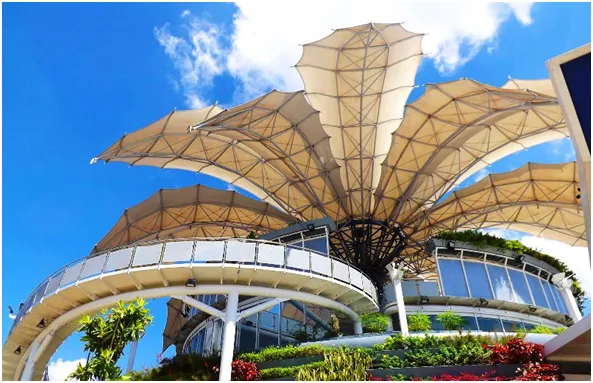
A sad note is that at present the flower petals do not open, some species of plants have died, as well as many fish and to top it off, its sense of a tourist-cultural center has been distorted. A ray of hope is still on, because having been declared a National Heritage, it is expected that an effort will be made not only to rehabilitate it, but also to keep it in good condition permanently.
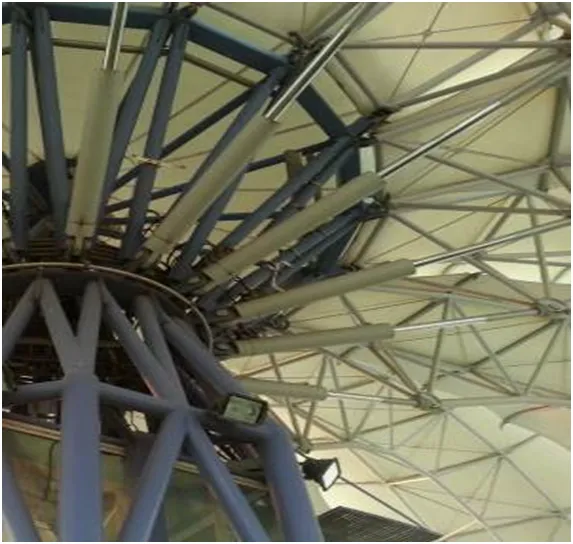
Works consulted:
I.-El pabellón de Venezuela en la expo 2000 de Hannover (Venezuela's pavilion in the hannover expo 2000). Ch. García-Dieg,; J. Llorens y H. Poppinghaus. Informes de la Construcción (Instituto de Ciencias de la Construcción Eduardo Torroja), vol. 53, nº 473, mayo-junio 2001.
II.-Rojas, Francisco Monumentos del Mundo: La Flor de Venezuela http://conversioneducativa.blogspot.com/2016/08/monumentos-del-mundo-la-flor-de.html
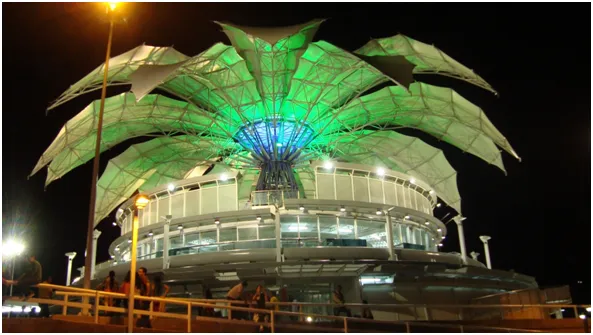
now “Flor de Venezuela” ( La Flor de Hannover, ahora Flor de Venezuela) Image
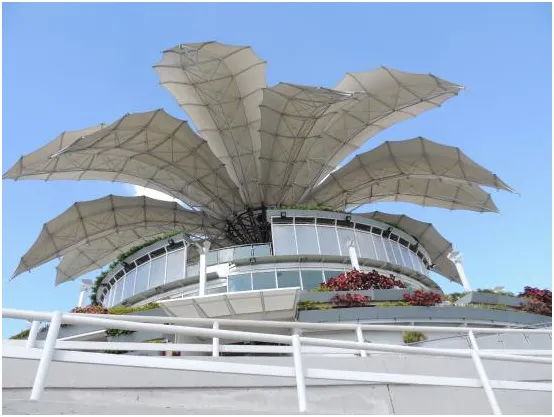
Estimados amigos de esta gran comunidad. En esta oportunidad me siento muy orgulloso de poder compartir con ustedes una de las joyas arquitectónicas de mi ciudad natal, Barquisimeto, situada a 350 kilómetros de Caracas.. Barquisimeto, capital del Estado Lara, ha sido denominada capital musical del país por ser el estado donde han surgido grandes músicos como el famoso guitarrista Alirio Díaz o el joven conductor Gustavo Dudamel, donde además se gestó el Sistema de orquestas de Venezuela bajo la dirección del maestro José Antonio Abreu. Pero además de músicos, en Barquisimeto se encuentras algunas de las más importantes e impresionantes obras de arquitectura moderna del país, las cuales tendré el placer de presentarles en algunos post en el futuro cercano. Espero los disfruten tanto como yo.
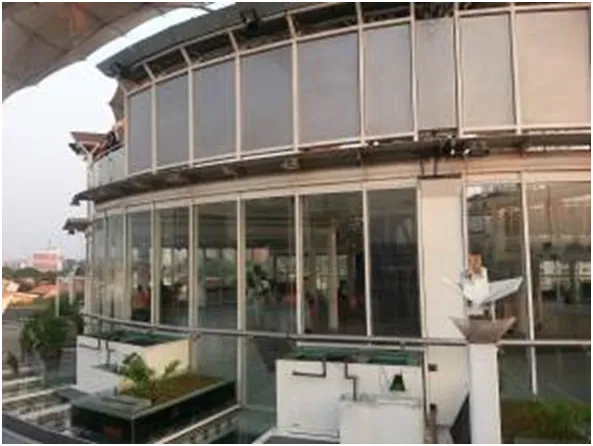
El Pabellón de Venezuela llamado por su autor "Una flor de Venezuela para el mundo", es producto de la mente genial del arquitecto tachirense Fruto Vivas con la colaboración de Frei Otto, el cual fue pensado para representar a Venezuela en la exposición ExpoHannover en junio del año 2000, donde participaron 156 países. El pabellón que ocuparía una extensión de 1600 metros cuadrados, debía cumplir con tres exigencias, unir las variables “humanidad, tecnología y naturaleza” en una sola obra. El diseño debía de realizarse en un tiempo escaso de 9 meses, lo que no le permitieron al autor y sus colaboradores desarrollar y experimentar soluciones totalmente novedosas; sin embargo, el éxito fue de tal naturaleza que los alemanes quedaron tan satisfechos con la obra que construyeron una réplica la cual ha sido colocada en donde estuvo la feria.

Fruto Vivas logró superar las dificultades y produjo una obra que expone la biodiversidad del país, con el uso de una solución ecológica que se adapta a las condiciones ambientales mediante la utilización de tecnologías de punta y el diseño y construcción de una estructura innovadora que aprovecha la luz natural y se ventila y refrigera sin que se produzca consumo eléctrico alguno, por la circulación del aire por convección a través de las jardineras escalonadas perimetrales hacia el capitel central. Todo esto rompió con los esquemas preexistentes de su época, lo que se vio reconocido por el galardón otorgado como primer premio de diseño, entre 487 concursantes, además de ser catalogada como la primera estructura mutante del siglo XXI, y ser el pabellón visitado por 18 millones de personas en la feria de Hannover, segundo solo detrás del de Alemania.
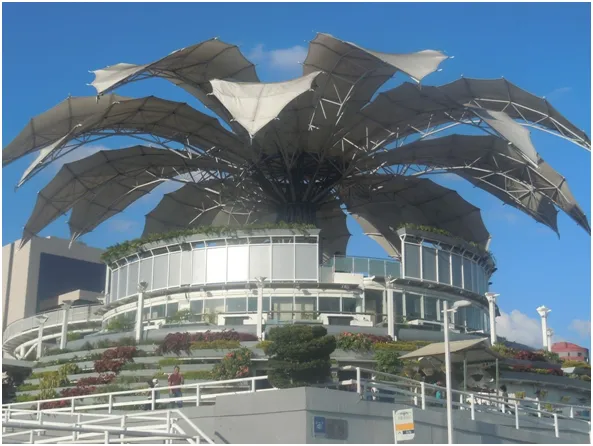
Mientras todas las estructuras fueron destruidas al terminar la exposición, el pabellón venezolano fue desmontado y trasladado a su país natal, donde estuvo guardado en contenedores por espacio de seis años. Originalmente se pensó que sería reconstruida en Caracas en el Parque del Este, actual Parque Miranda, pero por razones que no viene al caso, no se logró llegar a un acuerdo por lo que tuvo que buscarse otra sede, con la suerte de que la ciudad de Barquisimeto tomó la decisión de montarla en sus predios, lo que se logró luego de tres años de difícil y arduo trabajo y la convirtió en el “Centro Cultural Flor de Venezuela”, que fue declarada posteriormente “Patrimonio Cultural de la nación”. Como dato ecológico se puede decir que durante la construcción no hubo residuos porque fue realizado en seco, con materiales reciclables que pueden desmontarse sin producir contaminación
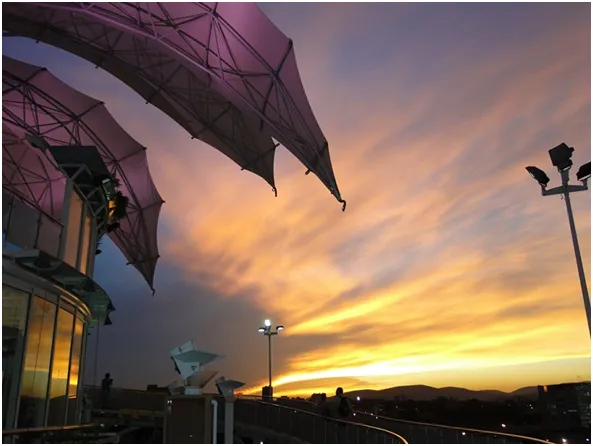
La estructura fue reconstruida entre las avenidas Venezuela y Argimiro Bracamonte de la capital larense, en su interior se encuentra una muestra de la múltiple y rica fauna y flora nacional. Se han logrado tener en exposición unas doscientas mil plantas científicamente identificadas y dos mil seiscientos peces distribuidos en peceras. Por otra parte, la flor posee una biblioteca, un anfiteatro, escenarios para foros, conferencias y para la realización de manifestaciones artísticas y culturales.

Image
La obra es un edificio en forma circular, que semeja a una flor, de 38 metros de diámetro y 6 pisos de altura alrededor de un mástil central por donde circula el ascensor y además es el soporte de la cubierta configurada por 16 pétalos móviles. El tallo de la flor es un mástil de 18 metros de altura construido en celosía tubular para hacerlo liviano y darle transparencia. Los gigantes pétalos que están alrededor del mástil se abren o cierran para favorecer la temperatura interior de la estructura que, cuando la flor está totalmente abierta, despliega un diámetro de 38 metros. Los 16 pétalos de diez metros se abren ante la presencia del sol y cierran cuando la lluvia se asoma en el cielo. Al atardecer se iluminan con varios colores.
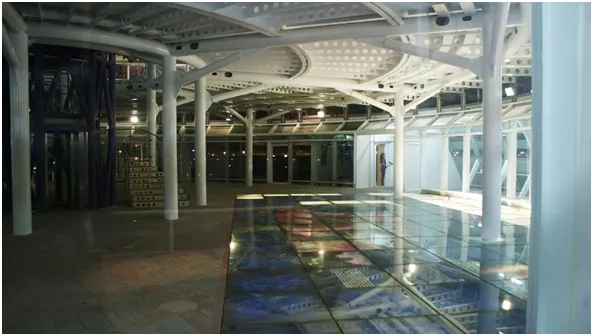
La cubierta asemeja a una flor; Fruto Vivas, cuando diseñaba la estructura de la obra, tenía en mente a los tepuyes de la Gran Sabana y a la orquídea Cattleya mossiae que es la flor nacional de Venezuela, por lo que debía mostrarse con movimientos parecidos a los de los pétalos, por ello la cubierta es una membrana textil cuyo soporte es una estructura ligera en forma tubular que se adapta a las diferentes posiciones que toman los pétalos durante sus movimientos.
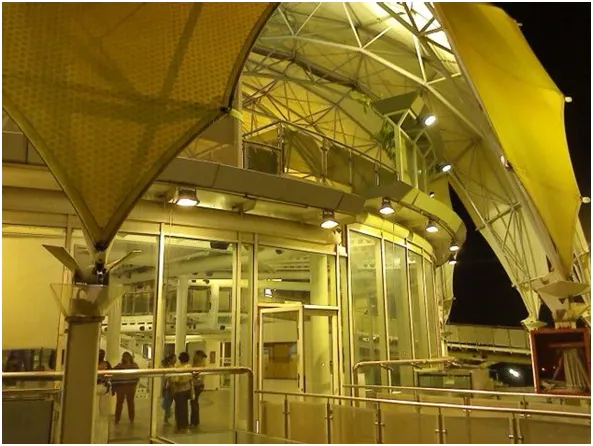
Una nota dolorosa es que en la actualidad los pétalos de la flor no se abren, algunas especies de plantas han fallecido, igual que muchos peces y para colmo, su sentido de centro turístico-cultural ha sido desvirtuado. Un rayo de esperanza aún está encendido, pues al haber sido declarada Patrimonio Nacional, se espera se haga el esfuerzo no solo por rehabilitarla, sino también de mantenerla en buen estado todo permanentemente.

Obras consultadas:
I.-El pabellón de Venezuela en la expo 2000 de Hannover (Venezuela's pavilion in the hannover expo 2000). Ch. García-Dieg,; J. Llorens y H. Poppinghaus. Informes de la Construcción (Instituto de Ciencias de la Construcción Eduardo Torroja), vol. 53, nº 473, mayo-junio 2001.
II.-Rojas, Francisco Monumentos del Mundo: La Flor de Venezuela http://conversioneducativa.blogspot.com/2016/08/monumentos-del-mundo-la-flor-de.html
